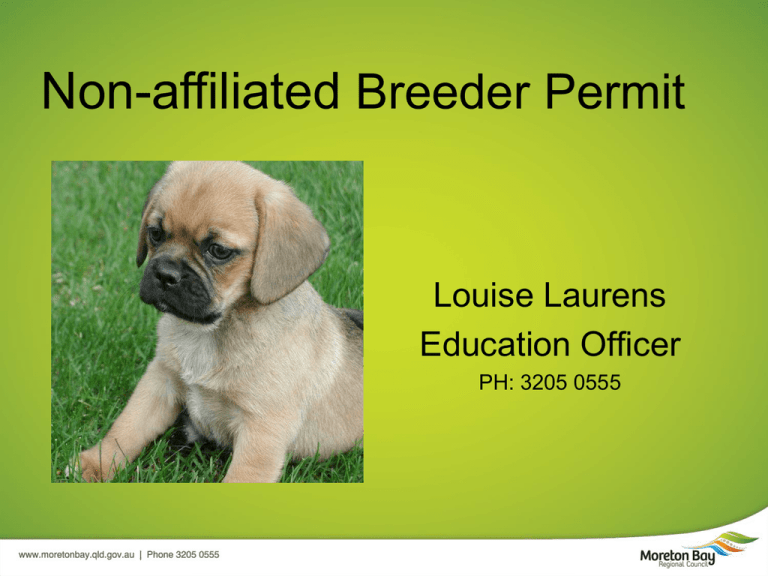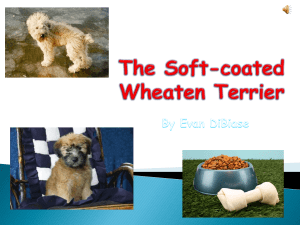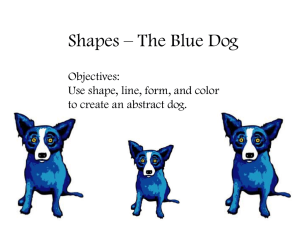
Non-affiliated Breeder Permit
Louise Laurens
Education Officer
PH: 3205 0555
Please view this presentation and
answer the short quiz
Once your quiz has been submitted
and your permit processed you will
be notified
The Non-affiliated Breeder Permit allows
MBRC residents to make application to keep
and breed dogs or cats providing that they
can establish that they can maintain, and
agree to maintain the animals nuisance free
and meet the minimum standards of care
and housing
The non-affiliated breeder permit will be
determined by the applicant's ability to meet:
•the permit conditions and
•property size
•housing
•fencing
•enclosures
•proximity of neighbours and
•history of any complaints
Animal Management (Cats and
Dogs) Act 2008
Part 2 Purposes and application of Act
Division 1 Purposes
3 Purposes of Act
The purposes of this Act are to—
(a) provide for the identification and registration of cats and
dogs; and
(b) provide for the effective management of regulated dogs;
and
(c) promote the responsible ownership of cat and dogs.
Note—
For the welfare of animals generally, see the Animal Care and
Protection Act 2001.
Part 3 Interpretation
Division 1 Dictionary
11 What is a cat or dog
(1) A cat is an animal of the species Felis catus, or domestic
cat.
(2) A dog is an animal of the species Canis lupus familiaris, or
domestic dog.
Chapter 3 Registration
Part 1 Particular person’s obligations
44 Registration obligation
(1) An owner of a cat or dog must comply with section 46 to
register the cat or dog in the relevant local government’s area
within 14 days after starting to keep the cat or dog in the area
unless the person has a reasonable excuse
Chapter 2 Identification of cats and dogs
Part 1 Prescribed permanent identification devices
Division 1 Obligation on supplier or owner of cat or dog
13 Supplier must ensure cat or dog is implanted
(1) A person must not, unless the person has a
reasonable excuse, supply a cat or dog to anyone
else if it is not implanted with a PID.
Note—
A cat or dog that is less than 8 weeks old must not
be implanted with a PID
Non-affiliated Breeder Permit
**Each individual dog / cat owned by the
permit holder must be registered**
Permit Conditions …
1. An onsite inspection of the property by an
authorised council officer is required prior to the
granting of this permit
2. All applicants must comply with the minimum
standards for the keeping of the specific animal
species including any conditions that may be
applied to an approved permit
Permit Conditions Cont’ …
3. Applicant must complete either
» On line course or
» Attend course at Council
4. Applicants are to include MBRC permit number
on all ads and website
A permit may be revoked at any time for a breach of
permit conditions
Minimum Standards
Minimum Standards Cont’ …
•
•
The keeper must ensure that the animal is
adequately identified so that the keeper’s
name, address and telephone number are
readily ascertainable, and
The keeper must ensure that waste waters
from enclosures are drained in a nuisance
free manner and that run-off is kept off
adjoining land or as otherwise directed by
an authorised person, and
Minimum Standards Cont’ …
•
The keeper must ensure that excreta, food
scraps and other material that is, or is likely
to become, offensive is collected at least
daily and, if not immediately removed from
the premises, is kept in a fly proof container
of a kind approved by the local government,
and
Minimum Standards Cont’ …
•
The keeper must ensure that any enclosure
in which the animal is kept is in a clean and
sanitary condition and free of dust and
odour, and
The keeper must ensure that the enclosure
is vermin free.
Minimum Standards Cont’ …
In addition to the general standards, a person who keeps an
animal or an animal of a specified species must also comply
with the minimum standards specified for the animal or
species of animal
For the avoidance of doubt, if there is an inconsistency
between a general standard and a specific standard, the
specific standard shall prevail
Breed History ….
Do you know your pet’s breed history??
Breeders are required under the permit to provide general information to
the new owners such as breed, health care, training etc
Eg: Terriers were bred to tirelessly hunt vermin. They have lots of attitude,
excess energy and often have an independent nature. Training is required.
Restricted Breeds
** DO NOT BREED **
American Pit Bull Terrier or Pit Bull Terrier
Fila Brasileiro
Japanese Tosa
Dogo Argentino
Perro de Presa Canario or Presa Canario
Records …
Keeping clear breeding records is highly
recommended
• Date of birth of each litter, colour, sex, new owner
• Vet history – vaccinations, worming, issues
• Identification – microchip numbers
Problems
High demand for puppies and kittens often creates:
Bad breeding
1.
2.
Nervous / unsound animals
Pets that have a tendency to snap or show aggression
Medical problems
–
–
–
Eyes
Skin
Joints
** Behaviour related problems are linked to, however are not limited to, genetics,
environment, lack of training and hormones **
Breeding …
Have you considered the costs involved not
only for the litter but if mum requires treatment
or surgery?
Do you have the time required if the litter
require a helping hand?
Breeding Cont’ …
• Pets should be over 12 months of age to
have their first litter
• Mum should be fit and in good health before
mating
• Mum should be vaccinated, microchipped,
worm and flea FREE
• Worms can be passed through the milk
supply or placenta
Hereditary diseases …
Hereditary diseases can be passed on from the
parents to the offspring
examples:
•
•
•
•
Heart and kidney disease
Hip dysplasia
Blindness
Entropion
Take reasonable steps to avoid hereditary diseases
Genetics …
• Each animal is composed of cells
• Each cell has a central nucleus that contains the genetic material
inherited from its parents
• The chromosomes are made up of DNA
• The chromosomes are in pairs and one of each pair is inherited from
each parent – 1 from mum + 1 from dad
• A gene is a particular section of a chromosome at a certain location
• Each gene has a specific role in determining the development of a certain
feature of that animal
• 50% of an animal’s genetic material comes from mum and 50% from dad
Genetics continued…
So what does this mean for your breed?
• An aggressive parent may lead to the litter having
aggressive tendencies
• A parent with a genetic eye problem will pass this
trait on to the litter
A future buyer may find this very costly to fix and it
can be very distressing to the animal
Ideal ‘parents’
• Fit and healthy
• Sound temperament
• Free from hereditary disease
• Mum and dad matched in size
• Not displaying any genetic faults
• Sexually mature (over 12 months of age)
Pets that are related should not be allowed to breed with each other
(eg mother & son, father & daughter, brother & sister)
Is your pet both mentally and physically sound?
Puppies and Kittens
All puppies and kittens will learn and mimic
their mother – both the good and the bad
*** A mum that panics easily will stress her litter ***
Pregnancy
•
•
•
•
Cat’s Gestation – average 63-65 days
Dog’s Gestation – average 63-65 days
Week 1 to 5 – no change
Week 5 - treat for internal and external parasites
(worms and fleas), increase food intake by 25-50%
depending on breed and size of litter and feed 2-4
small meals a day and gentle exercise
• Feed good quality highly digestible growth (puppy or
kitten) food
Labour
• Whelping or queening area needs to be draught free dry, warm and safe
• Prior to labour starting mum may appear to be nesting, refuse food, appear
restless or clingy, pant or shiver
• The puppy or kitten will pass into the cervix and this creates the urge to push
• Whelping should occur within an hour after pushing has started
• Puppies/kittens maybe delivered 5-10 minutes apart others 20-60 minutes apart
• Seek veterinary assistance if mum is straining for more than 30-40 minutes
• Please call your local vet if you are concerned at any time
When they are born …
• During the first week of feeding mum will require 1.5
times her normal food intake
• By week three her will require up to 3 times her
normal intake
• For mum’s with large litters she should be allowed to
eat as much as she needs
• As the pups/kittens start eating solid foods reduce
mum’s food intake slowly
• Always ensure clean, fresh water is available
Weaning
Depending on the breed this normally
occurs 3-5 weeks of age.
Reducing mum’s food intake back to her
normal intake during this time will help
reduce her milk. During weaning excess milk can
lead to mastitis – the inflammation of the mammary glands.
Puppies and kittens …
• 3-4 weeks - teeth will begin to appear
• Soft, moist solid foods can be introduced
• 6-7 weeks – 4-5 small meals a day
• Feed each one separate to ensure everyone
is eating
Puppies and Kittens continued …
•
Worm all puppies and kittens fortnightly starting at 2 weeks of age
READ THE ADVICE GIVEN ON THE WORMING PREPARATION BEFORE DOSING
•
•
•
•
•
Provide plenty of soft toys to play with – this builds up muscles,
coordination and social skills
Play a radio or tv so your puppies and kittens can hear new sounds
Spend time with each puppy and kitten – gently handle them
Knowing your litter will help place them in the right home
8 weeks is the optimum age to go to their new home as the pups will
be able to best adapt to the outside world away from its siblings
Socialisation …
The first 3-4 months of life are the most
important, correct and positive socialisation is
vital for the healthy development of the animal
Responsible Breeder Understands
Keeping of the pets
Welfare of the pets
Breeding of the pets
Selling of the pets
Dispose of pets
Good record keeping
Let your litter have the best
start in life and be …
•
•
•
•
Well formed
Well fed
Free from parasites
Well adjusted
Local Laws Requirements
Adequate Fencing
Effective control
New owner information …
•
•
•
•
•
•
Vaccination certificate
Microchip paperwork including change of
ownership paperwork
Worming chart
General information including
Diet, grooming, training,
Receipt of sale
Generic handouts for all new owners will be
available for all permit holders
Please complete the following quiz ….
Good luck
Dog Groups …
Do you know your dogs history??
Toys, Terriers, Gundogs, Hounds, Working, Utility and Nonsporting
Dog Breeders are required under the permit to provide general
information to the new owners such as health care, training etc
Generic information will be available from Council
Toys …
Bred to be loving companions
Robust and Extremely tough
Affenpinscher, Australian Silky Terrier, Bichon Frise, Cavalier King Charles
Spaniel, Chihuahua (long and smooth coat), Chinese Crested Dog, English
Toy Terrier, Griffon Bruxellois, Havanese, Italian Greyhound, Japanese
Chin, King Charles Spaniel, Lowchen, Maltese, Miniature Pinscher,
Papillon, Pekingese, Pomeranian, Pug, Tibetan Spaniel, Yorkshire Terrier
Terriers …
Bred to tirelessly hunt vermin
Lots of attitude, excess energy, independent
nature
Airedale Terrier, American Staffordshire Terrier, Australian Terrier,
Bedlington Terrier, Border Terrier, Bull Terrier, Bull Terrier (miniature), Cairn
Terrier, Cesky Terrier, Dandie Dinmont Terrier, Fox Terrier (smooth and
wire), German Hunting Terrier, Glen of Imaal Terrier, Irish Terrier, Jack
Russell Terrier, Kerry Blue Terrier, Lakeland Terrier, Manchester Terrier,
Norfolk Terrier, Norwich Terrier, Parson Russell Terrier, Scottish Terrier,
Sealyham Terrier; Skye Terrier, Soft Coated Wheaton Terrier, Staffordshire
Bull Terrier, Tenterfield Terrier, Welsh Terrier, West Highland White Terrier
Gundogs …
Bred to find and retrieve game
Need regular, invigorating exercise
Bracco Italiano, Brittany, Chesapeake Bay Retriever, Clumber Spaniel,
Cocker Spaniel, Cocker Spaniel (American), Curly Coated Retriever,
English Setter, English Springer Spaniel, Field Spaniel, Flat Coated
Retriever, German Shorthaired Pointer, German Wirehaired Pointer, Golden
Retriever, Gordon Setter, Hungarian Vizsla, Hungarian Wire Haired Vizsla,
Irish Red and White Setter, Irish Setter, Irish Water Spaniel, Italian Spinone,
Labrador Retriever, Lagotto Romagnolo, Large Munsterlander, Nova Scotia
Duck Tolling Retriever, Pointer, Sussex Spaniel, Weimaraner, Weimaraner
(longhair), Welsh Springer Spaniel
Hound …
Bred to track using sight or smell
Scent hounds - use their smell to follow a trail
Sight hounds - use speed and stamina
Afghan Hound, Basenji, Basset Fauve De Bretagne, Basset Hound, Beagle,
Bloodhound, Bluetick Coonhound, Borzoi, Dachshund (long haired, miniature long
haired, smooth haired, miniature smooth haired, wire haired, miniature wire haired),
Deerhound, Finnish Spitz, Foxhound, Grand Basset Griffon Vendeen, Greyhound,
Hamiltonstovare, Harrier, Ibizan Hound, Irish Wolfhound, Norwegian Elkhound,
Otterhound, Petit Basset Griffon Vendeen, Pharaoh Hound, Rhodesian Ridgeback,
Saluki, Sloughi, Whippet
Working …
Bred to help man - guarding, leading, guiding, tracking, pulling
carts, water rescues, etc
Require training - active minds
Australian Cattle Dog, Australia Kelpie, Australian Shepherd, Australian Stumpy Tail
Cattle Dog, Bearded Collie, Bergamasco Shepherd, Belgian Shepherd Dog
(Groenendael, Laekenois, Malinois, Tervueren), Border Collie, Bouvier De Flandres,
Briard, Collie (rough and smooth), Dutch Shepherd, Finnish Lapphund, German
Shepherd Dog, Komondor, Kuvasz, Maremma Sheepdog, Norwegian Buhund, Old
English Sheepdog, Polish Lowland Sheepdog, Puli, Pumi, Shetland Sheepdog,
Swedish Lapphund, Swedish Vallhund, Welsg Corgi (Cardigan and Pembroke),
White Swiss Shepherd Dog
Utility …
Includes large breeds of livestock guardian, rescue and messenger type
dogs
Akita, Alaskan Malamute, Anatolian Shepherd Dog, Bermese Mountain Dog, Black
Russian Terrier, Boxer, Bullmastiff, Canadian Eskimo Dog, Central Asian, Shepherd
Dog, Dobermann, Dogue De Bordeaux, German Pinscher, Italian Corso Dog,
Kangal Dog, Leonberger, Mastiff, Neapolitan Mastiff, Newfoundland, Portuguese
Water Dog, Pyrenean Mastiff, Pyrenean Mountain Dog, Rottweiler, Samoyed,
Schnauzer, Schnauzer (giant), Schnauzer (miniature), Shiba Inu, Siberian Huskey,
Spanish Mastiff, St Bernard, Tibetan Mastiff
Non sport …
Boston Terrier, British Bulldog, Canaan Dog, Chow Chow; Dalmatian, Eurasier,
French Bulldog, German Spitz (Klein and Mittel), Great Dane, Japanese Spitz,
Keeshound, Lhasa Apso, Peruvian Hairless Dog, Peruvian Hairless dog (medium
and small), Poodle (minature, standard and toy), Schipperke, Shar Pei, Shih Tzu,
Tibetan Spaniel, Xoloitzcuintle
Restricted Breeds
** DO NOT BREED **
American Pit Bull Terrier or Pit Bull Terrier
Fila Brasileiro
Japanese Tosa
Dogo Argentino
Perro de Presa Canario or Presa Canario
Breed names
Registration names:
ANKC – Australian National Kennel Council
Spoodle = cocker spaniel x or poodle x
Records
Breeding records – DOB, colour, sex, new owner
Identification – microchip numbers
MBRC Code of ethics is currently being developed for
non-affiliated breeders
Problems
High demand for pups often creates:
Bad breeding
1.
2.
Nervous / unsound
Tendency to snap and show aggression
Medical problems
–
–
–
Eyes
Skin
Joints
** Behaviour related problems are linked to, however are not limited to, genetics,
environment, lack of training and hormones **
Cat breeds …
Groups 1 to 4
Cat Breeders are required under the permit to provide
general information to the new owners such as health
care, training etc
Generic information will be available from Council
Cats …
Group1
Persian, Exotic SH, Birman, Turkish Van, Norwegian Forest Cat, Maine Coon,
Ragdoll, Siberian
Cats …
Group 2
Siamese, Foreign White (Shorthair/Longhair), Balinese, Oriental Shorthair, Oriental
Longhair (Javanese)
Cats …
)
Group 3
British Shorthair, Manx / Cymric, Chartreux, Scottish Fold (Shorthair/Longhair),
Scottish Shorthair, Selkirk Rex (Long & Shorthair), Russian, Abyssinian, Somali,
Burmese, Cornish Rex, Devon Rex, German Rex, Korat, Australian Mist, Ocicat,
Bengal, Japanese Bobtail (Shorthair / Longhair), Singapura, Tonkinese, Bombay,
Burmilla (Long & Shorthair), Sphynx, Egyptian Mau, La Perm (Long & Shorthair)
Cats …
Group 4
Companion Pets
Responsible Breeder
Keeping of the pets
Welfare of the pets
Breeding of the pets
Selling of the pets
Dispose of pets
Good record keeping
Non-affiliated Breeder Permit
•Application Fee (non refundable) $130
•Annual Renewal Fee
$ 25
•Each animal
$ 20
**Each individual dog / cat owned by the
permit holder must be registered**
Local Laws Requirements
Fencing
Effective control
Generic handouts for all new owners will be
available for all permit holders
Please hand in your question card ….










